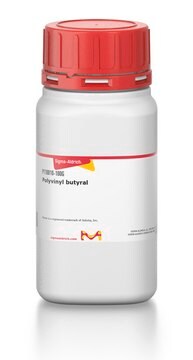189480
Poly(vinyl acetate)
average Mw ~100,000 by GPC, beads
Synonym(s):
Polyvinyl acetate
About This Item
Recommended Products
form
beads
mol wt
average Mw ~100,000 by GPC
viscosity
17-21 sec.(25 °C, Ford, no. 4)(lit.)
density
1.18 g/mL at 25 °C
storage temp.
2-8°C
SMILES string
COC(=O)C=C
InChI
1S/C4H6O2/c1-3-6-4(2)5/h3H,1H2,2H3
InChI key
XTXRWKRVRITETP-UHFFFAOYSA-N
Looking for similar products? Visit Product Comparison Guide
General description
Application
- Starting material to prepare polymer fibers for gas and humidity sensor applications. Citric acid-doped PVAc nanofibrous mats can be used to develop sensors for trimethylamine gas at room temperature.
- Polymer coating for floating tablets showing a controlled drug delivery. PVAc is a suitable excipient to ensure reliable and safe drug release. PVAc-based matrix tablet flow due to intrinsic low density and high elasticity of polyvinyl acetate coating.
Storage Class Code
11 - Combustible Solids
WGK
nwg
Flash Point(F)
Not applicable
Flash Point(C)
Not applicable
Personal Protective Equipment
Certificates of Analysis (COA)
Search for Certificates of Analysis (COA) by entering the products Lot/Batch Number. Lot and Batch Numbers can be found on a product’s label following the words ‘Lot’ or ‘Batch’.
Already Own This Product?
Find documentation for the products that you have recently purchased in the Document Library.
Customers Also Viewed
Our team of scientists has experience in all areas of research including Life Science, Material Science, Chemical Synthesis, Chromatography, Analytical and many others.
Contact Technical Service






